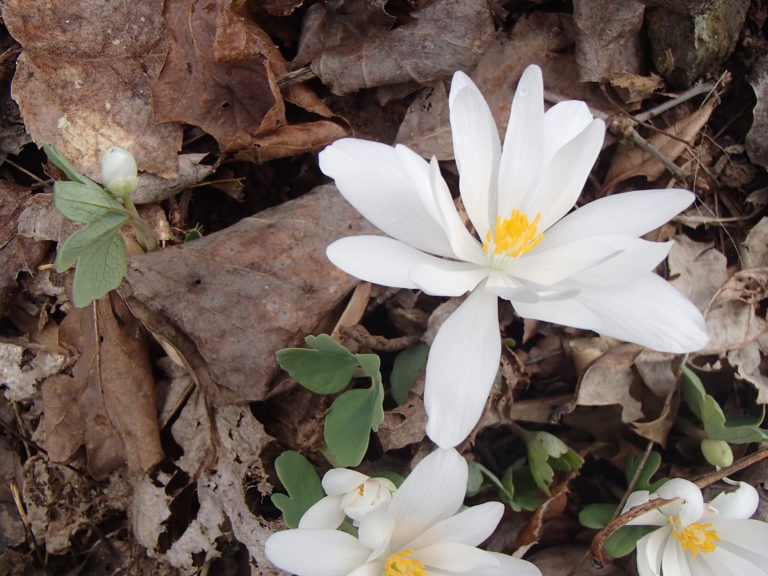A bright spring ephemeral and one of the first flowers to emerge in the brown, still-dormant forest, the Bloodroot is an exciting harbinger of wonderful things to come. The delicate white flower with prominent golden stamens emerges on a single stalk arising from a woody rhizome, opening during the day and closing at night. This occurs before the tree canopy above has formed. As a flower emerges, the deeply lobed leaf associated with it begins to unfurl. The attractive foliage grows larger and persists until mid summer when the plant returns to dormancy. Each fragrant flower is generally short lived (only a few days) but colonies – and floral displays – can be quite large and long lasting. The colonies are enlarged not only by rhizomes but also by seed. The seeds of Bloodroot have fleshy, sugary appendages known as elaiasomes which are attractive to ants. Ants carry the seeds away, significant distances. The common name is in reference to the sap produced by the Bloodroot’s woody rhizome as well as its foliage, which is a deep ‘blood’ red. This sap is poisonous if ingested, and care must be taken handling these plants (seriously!)
NURSERY HOURS
Wednesday: 10-4 Thursday: 10-6 Friday-Saturday: 10-4 Sunday: 12-4
Sanguinaria canadensis

Key Info
Scientific Name: Sanguinaria canadensis L.
Common Names: Bloodroot, Bloodwort, Redroot, Red puccoon, Pauson, Tetterwort
Family Names: Papaveraceae (Poppy Family)
Plant Type: Herbaceous perennial
Flower Color: White with prominent golden stamens
Additional Info
Habit: Foliage and floral stalk arise from a thick, reddish, woody rhizome system with bright orange sap and coarse fibrous roots, growing at or slightly below the soil surface and forming vegetative colonies.
Height: 0.5-0.75'
Spread: 0.25-0.5'
Soil Conditions: Average, Moist well-drained, circumneutral pH, humus-rich soil;
Leaves: A single, bluish green basal leaf is wrapped around the flowering stalk; is 3 to 5 inches across, succulent in texture, rounded in outline, with 5 to 9 palmately arranged lobes with undulating margins and pronounced venation; continues to expand as the flower withers away, persisting until mid-summer.
Flowers (or reproductive structures: A 3-4 inch stout flowering stalk supports a single flower 1½ - 3 inches across consisting of 8-16 white petals, a green oval pistil, and numerous stamens with prominent yellow anthers. The pistil has a pale yellow stigma at its apex. There are 2 light green sepals that are nearly as long as the petals, but they fall off the flowering stalk as soon as the flower begins to bloom. The flowers produce pollen but no nectar. The blooming period occurs from early to mid-spring, lasting about 2 weeks. (Illinois wildflowers.info)
Fruit: Each flower develops ito an elongated capsule 1½ to 2¼ inches long, which ripens before the foliage goes dormant, splitting open to release seeds. The seeds are round and black to orange-red when ripe, and have white elaiosomes, which are eaten by ants. Seeds ripen apporximately four weeks after the plant has flowered.
Natural Distribution: Rich deciduous woodlands, wooded slopes, edges of bluffs, shaded ravines, banks of rivers. Bloodroot is rarely found in disturbed sites.
USDA Hardiness Zone: 3 to 8
USDA Wetland Indicator Status in NC: UPL
Pollination: Small bees and flies.
Wildlife Connections: Pollen of the flowers attracts various kinds of bees, flies and beetles; the seeds are dispersed by ants.
Propagation: By fresh seed (plant immediately, do not let seeds dry out); by division of rhizome in spring or fall. Wear gloves handling the rhizomes.
